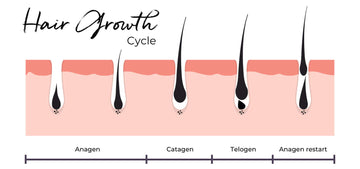Read Time: 3 min 19 sec
Haircare is so much more than we think. While a #selfcare moment featuring a hair mask and some leave-in-conditioner is beneficial to our locks and good for the soul, true haircare requires an understanding of how our hair functions.
All of the 100,000 hairs on our head go through the same four stages of growth: anagen, catagen, telogen, and exogen. (Is anyone else having flashbacks to high school biology class?) The time spent in these four stages will vary from person to person, as we know not all hair is created equal. However, having an understanding of how these stages affect your hair will give you a new perspective on how to treat your hair moving forward.
It’s important to note that every hair follicle in your head is on its own timeline.

Phase One: Anagen
You may have heard something along the lines of “hair texture changes every seven years,” and while that is not exactly true, there is a bit of truth behind that statement. At all times, about 90% of our hair is in the anagen phase, your hair’s growing stage. Each strand has a growing stage of three to five years. During these years our hair typically grows half an inch per month, however (if you’re lucky) some people may have genetically longer growing stages and their hair grows at a faster rate. We notice this phase over time, but it is most apparent after we get our hair cut, as strands in the anagen phase will quickly extend past the obvious trim line. Because the majority of our hair is in this stage at all times, it is vital that we consistently practice a healthy haircare routine.
Phase Two: Catagen
Consider the catagen phase a stage of puberty. It serves as the transitional period of a hair follicle’s life before it hits adulthood. During this phase, your hair follicle is shrinking in preparation for the last two phases and the new strand that will eventually emerge. Catagen typically only lasts a couple of weeks and is hardly recognizable.
Phase Three: Telogen
Your hair is l-i-t-e-r-a-l-l-y doing nothing for three months (wouldn’t that be nice) in the telogen phase. The hair follicle has reduced in size enough to still allow the hair to remain in place and allow for a brand new strand to begin growth. While this new strand of hair is beginning to develop, there are no visual changes to your hair.
Phase Four: Exogen
As one might have guessed, the exogen phase is when the hair exits the follicle. Daily we will lose, at most, 100 strands of hair. This phase can last up to five months, and while these numbers may seem alarming, please note that at any given time, your hair is consistently shedding up to 10% of its entirety. Once the hair has fallen out, the anagen phase begins and the cycle restarts.
If you live in a region that experiences frequent seasonal changes, your hair will adjust to these patterns. For example, your exogen phase may start in the summer, but the bulk of these hairs may release in the fall as the weather turns.
Caring For Your Hair Throughout These Cycles:
Because the majority of your hair spends most of its life in the anagen phase, giving your hair strong building blocks is the best way to care for it. This means basic solutions like taking vitamins, exercise (yes, it affects your hair growth), and reducing stress levels, but there are also a few more steps you can take to ensure your hair has the best chance of reaching maximum growth.
Shampoo and Conditioner

What you wash and nourish your hair with acts as a foundation. Shampoos and conditioners produced with empty ingredients and fillers will weigh your hair down and clog your hair follicles, reducing your growth opportunity. A good shampoo and conditioner will cleanse the scalp while providing enough moisture that your hair follicle can produce the oils it needs to benefit the hair strand. Find out more information on why this oil production is essential to a healthy head of hair here.
Stimulate Your Hair Follicles
That’s right ladies. Scalp massages aren’t just for TLC. Stimulated hair follicles are more active and therefore work harder to produce longer strands. We recently added a tool to our collection that will turn your shower into the healthy hair, mini-spa of your dreams.
Prevent Breakage

Think of hair damage the same way you would a hangnail. Drying it out or continuously bothering the hangnail will eventually make the damage work down to the nail bed. The same goes for hair. To prevent breakage from reaching the roots we suggest the following: Always use a heat protectant. Avoid the overuse of direct heat. Whenever you brush your hair, start with the bottom section and slowly work your way up to prevent any ripping or breakage.
Take care of those luscious locks regularly and in time, you will notice how differently it grows!
For more tips and hair tutorials, follow us on Facebook, Instagram, YouTube, and Pinterest.





